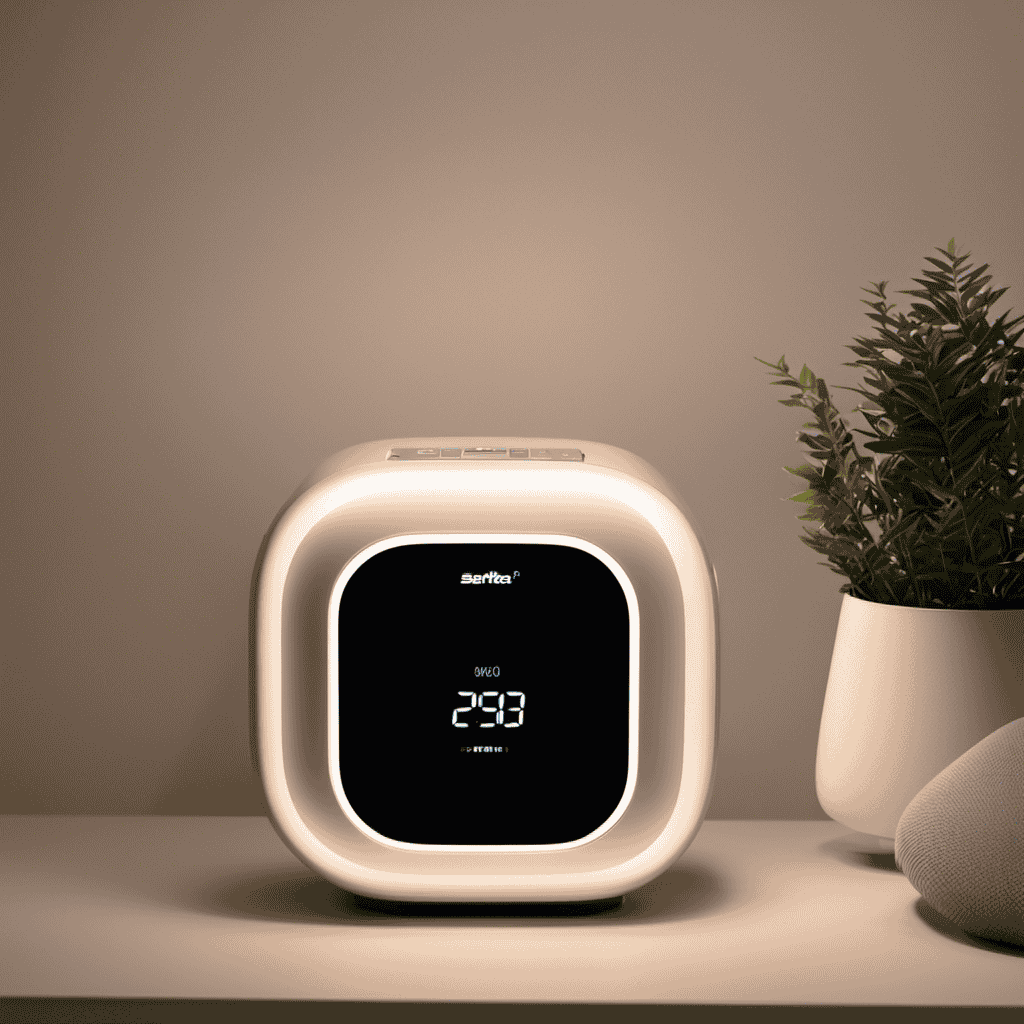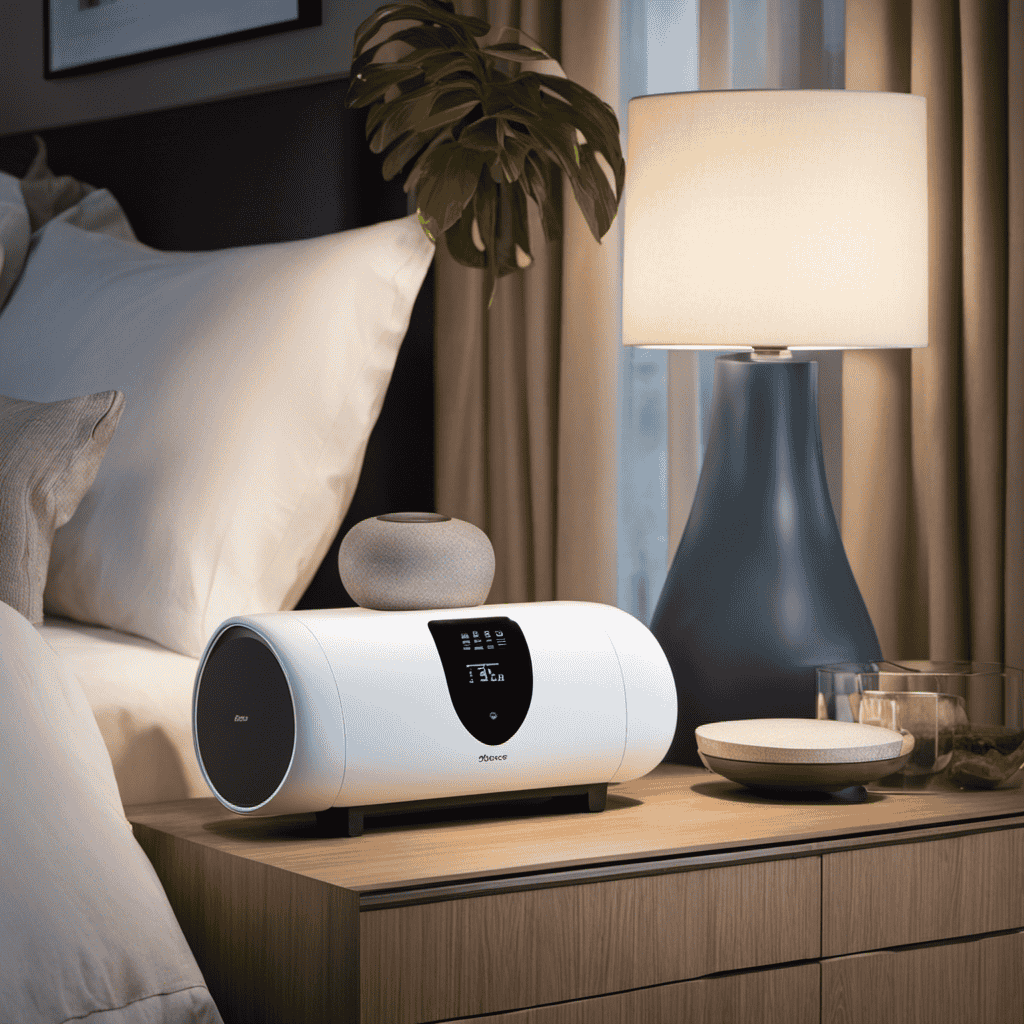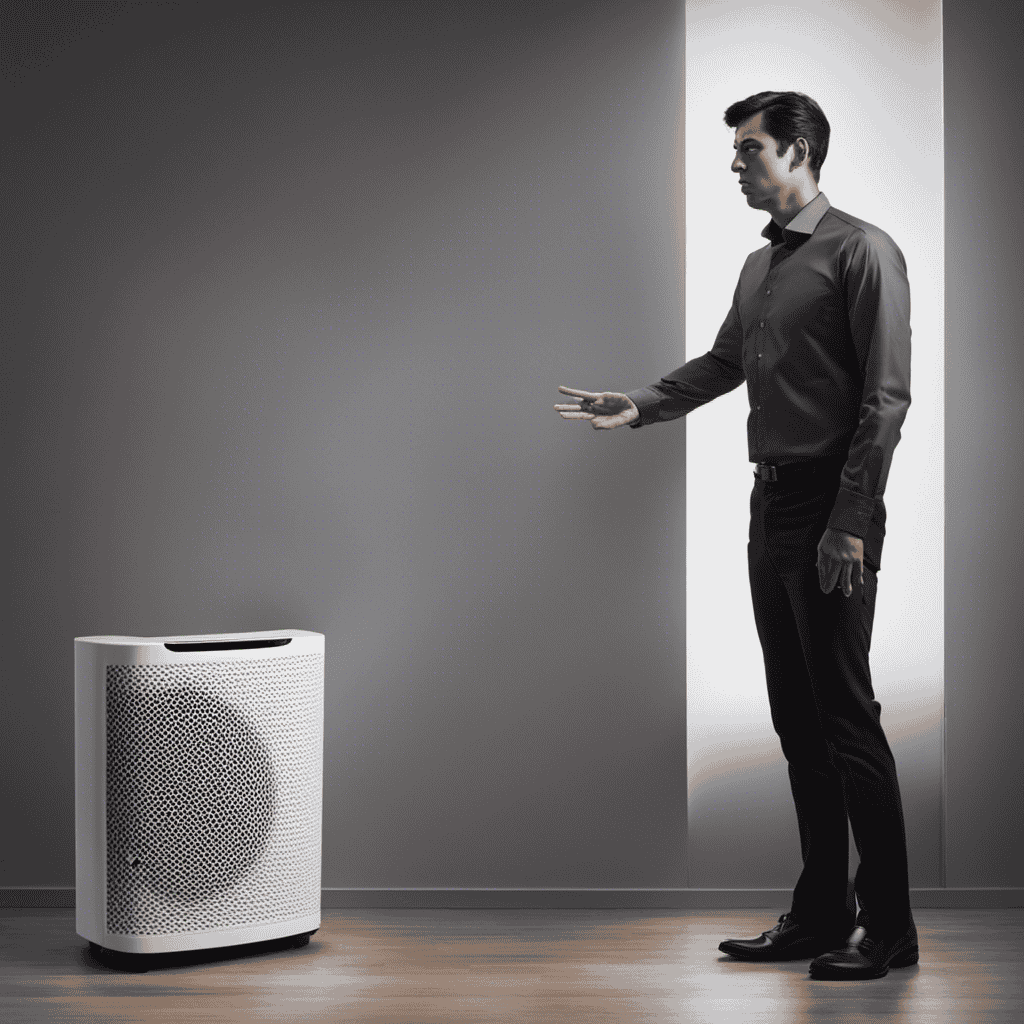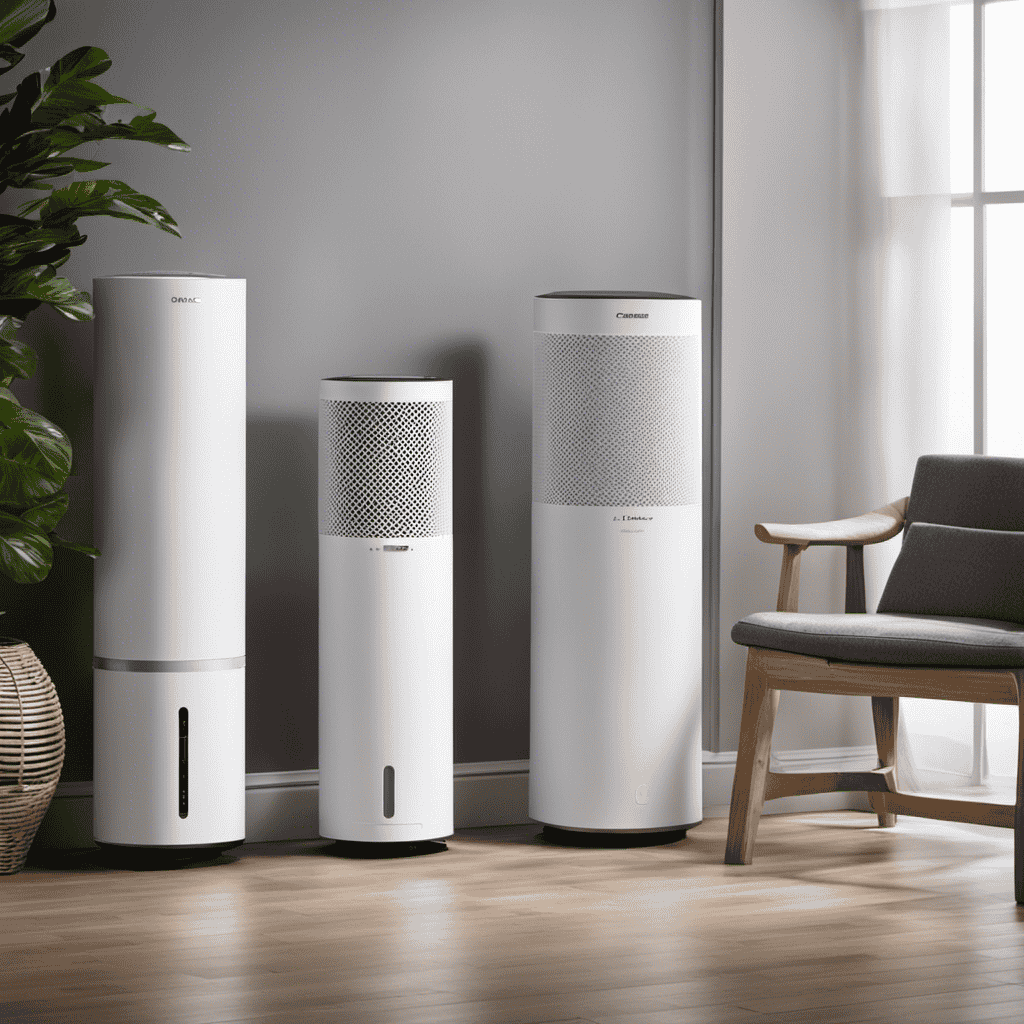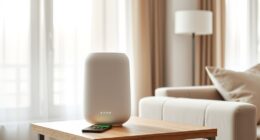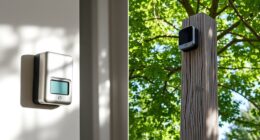As someone curious about improving the air quality in my home, I decided to explore ion air purifiers. I was pleasantly surprised by the significant impact these devices can have.
In this article, we will explore the inner workings of ion air purifiers, the myriad benefits they offer, and the different types available. Prepare to be enlightened on the key features to look for, the science behind ionization technology, and how to properly maintain these purifiers.
Let’s embark on a journey to enhance our indoor air quality together.
Key Takeaways
- Ion air purifiers use electrically charged ions to remove airborne particles and pollutants from the air.
- They emit negatively charged ions into the air, which attach to positively charged particles and cause them to become heavy and fall to the ground.
- Ion air purifiers improve air quality by removing harmful particles, reducing allergens and dust, and eliminating odors.
- When buying an ion air purifier, consider factors such as room size, CADR, noise level, and budget, and be aware of the potential side effects and the need to follow safety guidelines.
How Does an Ion Air Purifier Work
An ion air purifier uses electrically charged ions to remove airborne particles and pollutants from the air. This type of air purifier is effective in improving indoor air quality.
The ionizing technology employed by these purifiers works by emitting negatively charged ions into the air. These ions attach themselves to positively charged particles in the air, such as dust, pollen, and smoke.
Once the particles are negatively charged, they are attracted to positively charged surfaces in the room, such as walls or furniture. This process effectively removes the particles from the air, reducing their concentration and improving air quality.
The ion air purifier’s effectiveness in removing airborne pollutants makes it a popular choice for individuals looking to create a cleaner and healthier indoor environment.
Benefits of Using an Ion Air Purifier
Air quality improvement, allergen reduction, and dust reduction are key benefits of using an ion air purifier. By emitting negatively charged ions into the air, the purifier helps to remove harmful particles and pollutants, improving overall air quality.
These ions also attach to allergens and dust particles, causing them to become heavier and fall to the ground, effectively reducing allergens and dust in the air.
Air Quality Improvement
Improve your air quality with an ion air purifier. Ion air purifiers work by releasing negatively charged ions into the air, which attach to airborne particles and cause them to become heavy and fall to the ground. This process effectively removes pollutants, allergens, and odors from the air, resulting in cleaner and fresher indoor air.
It is important to note that while ion air purifiers can effectively remove airborne particles, they do not have filters to trap these particles like traditional air purifiers do. Therefore, it is crucial to ensure proper air circulation in the room where the ion air purifier is being used. This can be achieved by opening windows, using fans, or installing a ventilation system, which will help to bring in fresh air and remove any trapped pollutants.
Allergen and Dust Reduction
By using proper ventilation and regularly cleaning surfaces, you can effectively reduce allergens and dust in your home. Here are four ways to control allergens and dust and enjoy the benefits of clean air:
-
Use high-efficiency air filters: Install air filters with a high MERV rating (Minimum Efficiency Reporting Value) to capture smaller particles, including allergens and dust, from the air.
-
Vacuum regularly: Use a vacuum cleaner equipped with a HEPA filter to effectively remove dust, pet dander, and other allergens from carpets, rugs, and upholstery.
-
Keep windows closed: Pollen and outdoor pollutants can enter your home through open windows. Keeping them closed can help prevent allergens and dust from circulating indoors.
-
Use an air purifier: Consider investing in an air purifier with a HEPA filter to trap and remove allergens and dust particles, creating a cleaner and healthier indoor environment.
Types of Ion Air Purifiers
When comparing ionic air purifiers to electrostatic precipitators, it is important to understand the key differences between the two.
Ionic air purifiers use charged ions to attract and remove airborne particles, while electrostatic precipitators use an electric charge to trap particles on charged plates.
The benefits of ionization include the ability to remove smaller particles and pollutants, as well as the ability to neutralize odors and kill bacteria.
Maintenance of ionizers typically involves regular cleaning of the ionizing wires or plates to ensure optimal performance.
Ionic Vs. Electrostatic Precipitators
To understand the difference between ionic and electrostatic precipitators, you should know that the former uses charged ions while the latter relies on static electricity.
Here are the pros and cons of ion air purifiers:
-
Effectiveness: Ionic precipitators are efficient at removing smaller particles, such as smoke and pollen, from the air due to their ability to charge particles and attract them to a collection plate. Electrostatic precipitators, on the other hand, are better at removing larger particles like dust and pet dander.
-
Ozone production: Ionic precipitators can produce small amounts of ozone as a byproduct, which can be harmful to those with respiratory conditions. Electrostatic precipitators do not produce ozone.
-
Maintenance: Ionic precipitators require regular cleaning of the collection plates to maintain their efficiency. Electrostatic precipitators also require cleaning, but less frequently.
-
Cost: Ionic precipitators are generally less expensive upfront, but they may require more frequent replacement of parts. Electrostatic precipitators have higher upfront costs but may have lower long-term maintenance expenses.
Benefits of Ionization
If you’re looking to improve indoor air quality, one of the benefits of ionization is that it can help reduce the presence of airborne particles. Ionization works by releasing negative ions into the air, which attach themselves to pollutants such as dust, pollen, and pet dander. These particles become negatively charged and are attracted to positively charged surfaces in the room, such as walls or furniture. As a result, they are removed from the air, effectively purifying it.
This process is particularly effective in eliminating small particles that may not be captured by traditional air filters. Additionally, ionization can help neutralize odors and kill certain bacteria and viruses present in the air. This makes ion air purifiers a valuable tool in maintaining a clean and healthy indoor environment.
Maintenance of Ionizers
To properly maintain your ionizer, it’s important to regularly clean the collection plates and replace the filters as recommended by the manufacturer. Here are some ionizer maintenance tips and troubleshooting common issues:
-
Clean the collection plates: Remove the plates from the ionizer and gently wipe them with a soft cloth or brush. Avoid using water or harsh chemicals that could damage the plates.
-
Replace the filters: Follow the manufacturer’s guidelines on when to replace the filters. This ensures that the ionizer continues to effectively remove pollutants from the air.
-
Check for blockages: Inspect the air intake and outlet vents for any obstructions that could restrict airflow. Clear away any dust, debris, or pet hair that may have accumulated.
-
Address electrical issues: If the ionizer is not turning on or experiencing power fluctuations, check the power cord and outlet for any faults. Contact a qualified technician for repairs if needed.
By properly maintaining your ionizer, you can ensure its optimal performance and longevity.
Now, let’s explore the key features to look for in an ion air purifier.
Key Features to Look for in an Ion Air Purifier
One of the key features to look for in an ion air purifier is its ability to remove harmful particles from the air. Ion air purifier technology advancements have made it possible for these devices to effectively capture and neutralize pollutants, such as dust, pollen, pet dander, and even viruses and bacteria. These advancements have greatly improved the overall performance and efficiency of ion air purifiers, making them a valuable tool in reducing respiratory illnesses.
To help you make an informed decision, here is a table outlining the key features to consider when choosing an ion air purifier:
| Feature | Description | Benefits |
|---|---|---|
| Filtration System | Look for a purifier with a multi-stage filtration system | Traps a wide range of pollutants |
| Coverage Area | Consider the size of the room or area the purifier can cover | Ensures effective purification |
| Noise Level | Check the noise level of the purifier | Provides a quiet and peaceful environment |
| Energy Efficiency | Look for an energy-efficient purifier | Saves energy and reduces electricity costs |
| Additional Features | Consider any additional features like air quality sensors or smart controls | Enhances convenience and ease of use |
Understanding Ionization Technology
Now that we have discussed the key features to look for in an ion air purifier, let’s dive into understanding the ionization technology behind these devices.
Ion air purifier technology works by using an ionization process to improve the quality of the air we breathe. Here are the benefits of this process:
-
Removal of Airborne Particles: Ionization technology helps to remove airborne particles such as dust, pollen, pet dander, and mold spores from the air. The ions charge these particles, causing them to stick to surfaces or each other, making them easier to remove.
-
Elimination of Odors: Ionization technology also helps to eliminate unpleasant odors from the air. The ions neutralize the odor-causing molecules, effectively reducing the smell in the environment.
-
Reduction of Harmful Substances: Ion air purifiers can also reduce the presence of harmful substances such as bacteria, viruses, and volatile organic compounds (VOCs) in the air. The ions disrupt the structure of these substances, rendering them less harmful or inactive.
-
Improved Air Quality: By effectively removing particles, odors, and harmful substances, ion air purifiers contribute to improved indoor air quality, making the environment healthier and more comfortable to live in.
Understanding the ionization process and its benefits is crucial when considering an ion air purifier for your space.
Common Misconceptions About Ion Air Purifiers
Did you know that there are common misconceptions about how ionization technology works in improving indoor air quality?
One of the biggest misconceptions is that ion air purifiers produce harmful ozone levels. However, this is not entirely accurate. While it is true that ionizers produce a small amount of ozone as a byproduct, modern ion air purifiers are designed to emit ozone levels well below the safety limits set by regulatory bodies.
Another misconception is that ionizers can remove all types of air pollutants. While ionization technology is effective in removing certain types of particles, such as dust, pollen, and pet dander, it may not be as effective in removing volatile organic compounds (VOCs) or odors.
It is important to note that ion air purifiers should be used in conjunction with other air purification methods for comprehensive indoor air quality improvement.
Lastly, some people believe that ionizers can be harmful to individuals with respiratory conditions. However, when used correctly and within the recommended safety guidelines, ion air purifiers are generally safe for everyone. It is always advisable to follow the manufacturer’s instructions and take necessary safety precautions when using any type of air purifier, including ionizers.
Choosing the Right Size Ion Air Purifier for Your Space
To choose the right size for your space, you’ll need to consider the square footage of the area you want to purify. Here are four important factors to keep in mind when selecting the size of your ion air purifier:
-
Importance of proper placement for ion air purifiers: It is crucial to place the purifier in an area where it can effectively circulate and clean the air. Avoid placing it near walls or furniture that may obstruct airflow.
-
Energy efficiency of different sized ion air purifiers: Larger purifiers may consume more energy, so it’s important to choose a size that matches the square footage of your space to avoid wasting energy.
-
Consider the level of air pollution: If your space is prone to high levels of pollutants, such as smoke or allergens, you may need a larger purifier with a higher air cleaning capacity.
-
Noise level: Larger purifiers tend to have more powerful fans, which can generate more noise. Consider the noise tolerance of your space and choose a size that balances efficiency with comfort.
Properly sizing your ion air purifier ensures optimal performance and energy efficiency. However, it’s also important to regularly maintain your purifier to keep it functioning effectively and efficiently.
The Importance of Regular Maintenance for Ion Air Purifiers
Regular maintenance is essential for keeping your ion air purifier functioning effectively and efficiently. To ensure optimal performance, it is recommended to clean the ionization wires and collection plates every two to four weeks, depending on the level of air pollution in your environment. This maintenance frequency helps prevent the build-up of dirt and particles that can hinder the purifier’s ability to effectively remove contaminants from the air.
Additionally, it is important to regularly check the fan and motor for any signs of wear or damage, and replace them if necessary. If you encounter any issues with your ion air purifier, such as decreased airflow or strange noises, refer to the troubleshooting tips provided in the user manual or contact the manufacturer for assistance.
By properly maintaining your ion air purifier, you can ensure its longevity and effectiveness in improving indoor air quality.
Now that we understand the importance of regular maintenance for ion air purifiers, let’s explore how these devices can help with allergies.
Can Ion Air Purifiers Help With Allergies
In this discussion, I will be examining the efficacy of ionizers in reducing allergy symptoms and the potential side effects associated with their use.
Ionizers are air purifiers that work by emitting negative ions into the air, which attach to airborne particles and cause them to fall out of the air. Studies have shown that ionizers can help reduce allergy symptoms by removing allergens such as dust, pollen, and pet dander from the air.
However, it is important to consider the potential side effects of ionizers, such as the production of ozone, which can be harmful to human health.
Efficacy of Ionizers
Ionizers can help improve air quality by reducing the number of airborne particles. As a technical expert in air purification methods, I have extensively studied and compared different air purifiers, including ionizers. Here is a detailed analysis of the efficacy of ionizers:
-
Ionization Process: Ionizers work by emitting negative ions into the air, which attach to positively charged particles like dust, pollen, and smoke, causing them to settle down and be removed from the air.
-
Particle Removal: Ionizers effectively reduce the number of airborne particles, including allergens, pollutants, and odors, making the air cleaner and healthier to breathe.
-
Limitations: While ionizers are efficient at removing larger particles, they may not be as effective in eliminating smaller particles like viruses or bacteria. Additionally, ionizers can produce trace amounts of ozone, which can be a concern for individuals with respiratory issues.
-
Maintenance: Ionizers require regular cleaning to maintain their effectiveness. Filters and plates need to be cleaned or replaced to ensure optimal performance.
Allergy Symptom Reduction
If you suffer from allergies, using an ionizer can help reduce your symptoms by removing allergens from the air. An ionizer is an air purifier that works by emitting negative ions into the air. These ions attach themselves to positively charged allergens, such as pollen, dust mites, and pet dander, causing them to become heavy and fall to the ground. By doing so, the ionizer effectively removes these allergens from the air, providing allergy relief for individuals with sensitivities. Additionally, ionizers can also help eliminate other airborne particles, such as bacteria and viruses, further improving air purification.
| Allergens Removed | Benefits of Ionizers |
|---|---|
| Pollen | Allergy Relief |
| Dust Mites | Improved Air Quality |
| Pet Dander | Reduced Asthma Risk |
Using an ionizer as part of your allergy management strategy can significantly alleviate symptoms and improve your overall well-being.
Potential Side Effects
When using an ionizer, you may experience potential side effects such as dryness of the throat and skin irritation. These short term discomforts are common and usually subside once your body adjusts to the ionizer. However, it is important to be aware of potential long term safety concerns associated with ionizers.
Here are some key points to consider:
-
Ozone production: Some ionizers release ozone as a byproduct, which can be harmful when inhaled in high concentrations.
-
Electrostatic discharge: Ionizers can generate static electricity, leading to shocks or damage to electronic devices.
-
Airborne particles: Ionizers may cause particles to settle on surfaces, requiring more frequent cleaning.
-
Maintenance: Regular cleaning and filter replacement are necessary to ensure optimal performance and prevent the buildup of pollutants.
To mitigate potential risks, make sure to choose an ionizer with low ozone emissions, follow manufacturer’s instructions, and consider using in combination with other air purifying technologies.
Ion Air Purifiers Vs. HEPA Filters: Which Is Better
HEPA filters offer a different approach to air purification compared to ion air purifiers. While ion air purifiers use charged ions to attract and remove particles from the air, HEPA filters rely on a physical filtration process.
HEPA filters are made of densely packed fibers that can trap particles as small as 0.3 microns, including dust, pollen, pet dander, and mold spores. In contrast, ion air purifiers often claim to remove particles as small as 0.01 microns, but their efficiency may vary. Additionally, ion air purifiers may produce ozone as a byproduct, which can be harmful to the respiratory system.
In terms of odor removal, ion air purifiers may not be as effective as activated carbon filters, which can absorb and trap odors. UV filters, on the other hand, use ultraviolet light to kill bacteria and viruses. However, it’s important to note that UV filters may not be as effective against larger particles.
Ultimately, the choice between ion air purifiers and HEPA filters depends on individual needs and preferences. In the next section, we will explore whether ion air purifiers are safe for pets and children.
Are Ion Air Purifiers Safe for Pets and Children
As a researcher in the field of air purification, I’ve encountered a common concern about the safety of ion air purifiers for pets and children.
This discussion aims to address this concern by examining the potential health risks associated with ion air purifiers and their impact on pet and child safety.
Additionally, we will explore effective alternative options that provide similar air purification benefits without compromising the well-being of our beloved pets and children.
Pet and Child Safety
Make sure to keep your pets and children away from the ion air purifier to ensure their safety. While ion air purifiers are generally safe for household use, it is important to take precautions when it comes to the well-being of your loved ones.
Here are some key points to consider:
-
Potential Harmful Effects: Ion air purifiers emit negative ions into the air, which can cause respiratory irritation in pets and children with sensitive lungs.
-
Allergies and Asthma: Some individuals, especially those with allergies or asthma, may experience worsened symptoms when exposed to ion air purifiers.
-
Ozone Production: Certain ion air purifiers generate small amounts of ozone, which can be harmful when inhaled in high concentrations.
-
Electrical Risks: Ion air purifiers are electronic devices that should be kept away from curious pets and children to prevent electrical accidents.
Potential Health Risks
It’s important to be aware of the potential health risks associated with long-term exposure to ion air purifiers. While ion air purifier technology advancements have made these devices more efficient at reducing airborne pollutants, there are still concerns about their long-term effects on human health.
One potential risk is the generation of ozone, a harmful air pollutant that can irritate the respiratory system and worsen existing respiratory conditions. Another concern is the production of negative ions, which can react with other air pollutants to form harmful byproducts. Additionally, some studies have suggested that long-term exposure to negative ions may have negative effects on cardiovascular health.
Therefore, it is crucial to consider these potential risks and ensure that ion air purifiers are used in a well-ventilated area and operated according to manufacturer guidelines to minimize any potential long-term effects.
Effective Alternative Options
Consider exploring other options that can effectively improve indoor air quality and reduce the risk of respiratory issues.
Here are four alternative options that provide cost-effective solutions for enhancing the air you breathe:
-
Air purifying plants: Certain plants, such as the snake plant or peace lily, have the ability to filter harmful toxins from the air, acting as natural air purifiers.
-
Activated charcoal: This porous substance effectively absorbs impurities, odors, and chemicals present in the air. Placing activated charcoal in a container or using it in air purifying bags can help cleanse the indoor environment.
-
Ventilation systems: Proper ventilation is crucial in maintaining good air quality. Installing an energy-efficient ventilation system can effectively remove stale air and introduce fresh air from the outside.
-
Salt lamps: These lamps emit negative ions, which are believed to neutralize pollutants and allergens. Salt lamps can create a calming ambiance while potentially improving indoor air quality.
How to Clean and Care for Your Ion Air Purifier
To properly clean and care for your ion air purifier, you should regularly remove and clean the filter. Maintaining your ion air purifier is essential to ensure optimal performance and prolong its lifespan.
Start by turning off the device and unplugging it from the power source. Carefully remove the filter and gently tap it to remove any loose debris. Rinse the filter under running water to remove trapped particles and dirt. Allow the filter to air dry completely before reinstalling it.
Additionally, troubleshooting your ion air purifier is crucial if you encounter any issues. Check the power supply, make sure the unit is properly plugged in, and examine the control settings. If the problem persists, consult the user manual or contact customer support for further assistance.
In the next section, I will discuss the impact of ion air purifiers on indoor air quality.
The Impact of Ion Air Purifiers on Indoor Air Quality
Now that we’ve discussed how to clean and care for ion air purifiers, let’s delve into the impact they have on indoor air quality and respiratory health.
Ion air purifiers work by releasing negatively charged ions into the air, which attach to positively charged particles, such as dust, pollen, and pet dander. This process causes the particles to become heavy and fall to the ground, effectively removing them from the air.
Here are four key points to consider:
-
Ion air purifiers vs. UV air purifiers: While both types aim to improve indoor air quality, ion air purifiers focus on particle removal, while UV air purifiers target bacteria and viruses using ultraviolet light.
-
Particle reduction: Ion air purifiers can significantly reduce airborne particles, including allergens and pollutants, improving overall air quality.
-
Respiratory health benefits: By removing irritants from the air, ion air purifiers can help alleviate symptoms of allergies, asthma, and other respiratory conditions.
-
Ozone production: It’s important to note that some ion air purifiers may produce ozone as a byproduct, which can be harmful in high concentrations. Ensure your ion air purifier meets safety standards and has low ozone emissions.
Can Ion Air Purifiers Remove Odors
If you’re wondering whether ion air purifiers can effectively remove odors, the answer is yes! Ion air purifiers are equipped with ionization technology that helps eliminate unpleasant odors in the air.
These purifiers work by emitting negatively charged ions into the air, which attach to positively charged odor particles, causing them to become heavy and fall out of the air. This process effectively removes various odors, including those from cigarette smoke.
However, it’s important to note that some ion air purifiers may emit ozone as a byproduct of ionization. Ozone is a molecule that can have harmful effects on human health, especially in high concentrations.
Therefore, it is crucial to choose ion air purifiers that have low ozone emissions or are ozone-free. Look for purifiers that are certified by reputable organizations such as the California Air Resources Board (CARB) or the Asthma and Allergy Foundation of America (AAFA) to ensure their safety and effectiveness in odor removal.
Factors to Consider When Buying an Ion Air Purifier
When considering which ion air purifier to purchase, make sure to prioritize factors such as room size, filtration efficiency, and noise level. These key factors will help you find the best ion air purifier that meets your specific needs. Here are the top factors to consider:
-
Room Size: Determine the square footage of the room where the purifier will be used. This will help you select a purifier with the appropriate coverage area.
-
Filtration Efficiency: Look for a purifier that has a high CADR (Clean Air Delivery Rate) and HEPA (High-Efficiency Particulate Air) filters. These features ensure effective removal of airborne pollutants.
-
Noise Level: Consider the noise level of the purifier, especially if you plan to use it in a bedroom or office. Look for models that offer quiet operation.
-
Price Range: Set a budget for your ion air purifier purchase. Consider the initial cost of the purifier, as well as any ongoing maintenance or filter replacement costs.
Frequently Asked Questions
Are Ion Air Purifiers Effective at Removing Viruses and Bacteria From the Air?
Yes, ion air purifiers are effective at removing viruses and bacteria from the air. They use ions to charge particles, causing them to stick to surfaces. This method is efficient compared to other types of purifiers.
Can Ion Air Purifiers Help With Respiratory Conditions Such as Asthma?
Yes, ion air purifiers can help with respiratory conditions like asthma by removing allergens from the air. However, they can be harmful to pets as the ions can irritate their respiratory systems.
How Long Does It Take for an Ion Air Purifier to Clean the Air in a Room?
It takes mere moments for an ion air purifier to work its magic and cleanse the air in a room. With its numerous benefits and minimal maintenance, it’s a technological marvel worth investing in.
Do Ion Air Purifiers Produce Any Harmful Byproducts or Ozone?
Ions air purifiers do not produce harmful byproducts or ozone. They work by releasing negatively charged ions into the air, which attach to pollutants and neutralize them, improving air quality without any negative side effects.
Are Ion Air Purifiers Noisy When They Are Operating?
Ion air purifiers can be quite noisy when operating, emitting a constant hum that can disrupt your peace. However, there are ways to reduce the noise levels, such as placing the purifier on a stable surface or using sound-absorbing materials.
Conclusion
In conclusion, the ion air purifier is a powerful tool in improving indoor air quality. With its ionization technology, it effectively removes pollutants and allergens from the air, creating a healthier living environment.
From my own experience, I’ve noticed a significant reduction in dust and allergies since using an ion air purifier in my home. The metaphorical power of this device is akin to a superhero, fighting against invisible enemies and providing clean, fresh air for you and your loved ones to breathe.
So, invest in an ion air purifier today and experience the transformation in your indoor air quality.

